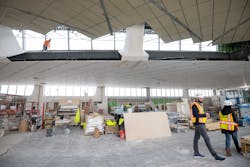The Chicago O’Hare International Airport (ORD) is in the midst of a major multi-dimensional and multi-phase infrastructure improvement project, O’Hare 21. The project includes three signature projects: Terminal 5 Expansion and Modernization; Terminal Area Plan which includes construction of two satellite concourses and O’Hare Global Terminal; and the completion of Runway 9C-27C, part of the O’Hare Modernization Program.
Runway 9C-27C was completed in 2020, the Terminal 5 Expansion Project is projected to finish this year while the two satellite concourse projects are expected to commence this year. The O’Hare Global Terminal construction is expected to commence in 2026.
“O'Hare 21 really is a generational capital investment in O'Hare's facilities that will take approximately 15 years to put in place,” said City of Chicago Department of Aviation Chief Development Officer Robert Hoxie. “The purpose of the program is to transform O'Hare and give it terminal facilities primarily that are fit for purpose for the 21st century.”
Hoxie said O’Hare 21 is trying to achieve four major priorities: replace aging infrastructure, improve terminal facilities, improve passenger amenities, and increase gate capacity.
“Just last month we celebrated the 60-year anniversary of President John F. Kennedy's ribbon cutting on O'Hare Terminals 2 and 3. 60 years old, right? A lot of buildings start to require investment when they get up to that age, so replacing aging infrastructure is probably the single biggest component of the O'Hare 21 investment program,” Hoxie said.
“A third major component is improving the terminal facilities and the level of service afforded to passengers and to the people that work there every day,” Hoxie said. “That's bigger hold rooms, more food and beverage offerings, more amenities, and overall nicer spaces that are properly sized for the types of volumes that are using them day in and day out.”
As part of O’Hare 21, the airport received an environmental approval on the Terminal Area Plan from the FAA in November of 2022.
“US Department of Transportation Secretary, Pete Buttigieg, was here in Chicago with Mayor Lightfoot and Commissioner Jamie Rhee to announce the FAA's decisions on the environmental, and that really allows us to move forward with construction on this exciting improvement,” Hoxie said.
Terminal 5 Expansion and Modernization
ORD’s $1 billion Terminal 5 Expansion and Modernization began in March 2019. Hoxie said the work in 2019 and 2022 was primarily focused on expanding remote aircraft parking areas.
“We broke ground on the building in March of 2020, which was a heck of a month to be undertaking a major expansion to an airport terminal when you think about what else was happening in the world that month. But that expansion continued on schedule,” Hoxie said. “In fact, COVID in many respects made the building component of the project more efficient. We didn't need to maintain as many gates during construction, we were able to re-sequence some of the construction, which made things more straightforward to construct.”
In summer of 2022, seven new gates opened in the extended East Concourse. 10 renovated gates opened in the West Concourse in October 2022.
Additional phases of Terminal 5 are expected to open throughout the 2023 year. Hoxie said the renovation of the International Arrivals Facility, Immigration and Customs, as well as the baggage handling system are scheduled to be complete later this year.
Upon completion, the project will add a total of 10 new gates to provide 25 percent more gate capacity, increase passenger amenity space by 85 percent, expand the existing building by about 350,000 square feet, renovate more than 750,000 square feet of the existing building, add more airline space, more concession amenities, integrate new furniture and technology, expand security checkpoints to 13, replace existing 25-year-old baggage handling systems, provide a six-story parking garage and expand the curbside area.
ORD worked with Muller2 (architect of record), HOK (lead designer), Millhouse Engineering and Austin Power Partners on the Terminal 5 project.
Muller2 Principal David Steele said the Terminal 5 Expansion and Modernization was a project designed to enable the replacement of Terminal 2.
“They had to create space to shift different tenants around in the airport so that they could tear down Terminal 2 and start that work,” Steele said. “They cleared out some previous space on the airport grounds that was used for other uses to create space for this new terminal added to the end of terminal – the original Terminal 5 – to accommodate this new growth in expansion of Terminal 2 into what they call, the global terminal, which is, that's like a main terminal plus two satellites and potentially even more satellite terminals in the future.”
Steele said this allowed ORD to shift Delta Air Lines over to Terminal 5.
“Since then, they've also brought in Southwest Airlines into Terminal 5,” Steele said. “So, it's a hybrid terminal now, it handles both domestic and international flights. Previously, it was just international.”
Key Features of Terminal 5
Throughout the terminal, ORD installed electrochromic glass from View that allows the windows to tint throughout the day.
“That's helpful for two major reasons,” Hoxie said. “One is environmentally it's better. It does more to reflect ultraviolet light and minimize the amount of heating that's occurring because of sunlight passing through glass. But it's also helpful for people inside the building, because it allows the light level to remain fairly consistent across the day.”
As part of the project, the Department of Cultural Affairs and Special Events and the Chicago Department of Aviation are commissioning the largest single acquisition of art by Chicago artists in the last 30 years.
The $3.5 million art project will be displayed in three different locations throughout the terminal featuring more than 20 artists.
Steele said the old terminal was built in a vastly different time for air travel.
“Airplanes are bigger now, there's more of them. So, the newer terminal standards are much larger than in the past,” Steele said. “So, the concourse of the new wing is about twice as wide as the original building, and it has fewer columns. So, there's bigger, longer spans with much more open, easier flowing space, longer views into the terminal, which accommodate better intuitive wayfinding where you need fewer signs.”
Steele said the new terminal also has much bigger windows with views out onto the airfield.
“You get great views of airplanes coming into the gates or taking off at the nearby runways, which was really exciting for people that are traveling and seeing the airfield operations, so clearly through the windows,” Steele said.
“The gates are also designed to hold multiple sized aircraft as big as A380 down to the smallest regional airplane, and that's due to arrangement of how the gates and bridges work makes the terminal extremely flexible for use by the airport,” Steele said. “Older terminals tend to not have that kind of flexibility.”
Technology
“Technology-wise, I think the complete replacement of the baggage handling system is something that you may not feel directly as a customer but makes a huge difference to the smoothness of your journey,” Hoxie said.
Hoxie said Terminal 5 is one of many terminal buildings in the country that had check baggage inspection systems retrofitted into them after the 9/11 terrorist attacks. This new baggage handling system clears a lot of the inefficiencies that were introduced with that retrofit, which occurred after 9/11, and provides more capacity and a more reliable way to screen, scan and sort bags.
“It also has provisions for storing bags that arrive early,” Hoxie said. “So, if you were connecting on a flight across O'Hare and you and your bag arrive eight hours early, there's actually a place to put that bag, as opposed to on a cart in a corner of a baggage area, increasing the likelihood that then it will make your downline flight. So overall, the baggage handling system, while not particularly sexy, is really important to running a reliable airport terminal.”
Parking
“Also, at Terminal 5, in June of 2022, we broke ground on a new six-level parking facility,” Hoxie said. “That is in construction now and is expected to be completed in 2024.”
The new garage will more than double the amount of available parking at the terminal and expand the capacity to offer a mix of short and long-term parking options.
“It will have electric chargers. 20 percent of the garages’ spaces will be ready for electric vehicles when it opens,” Hoxie said.
Handling a Multi-Dimensional Project
For an airport to undergo a multi-phased, multi-dimensional project that is the magnitude of O’Hare 21, Hoxie said there are many things that need to be considered.
“When I think about Terminal 5, a couple of things stand out,” Hoxie said. “One is that there were extensive alterations and renovations made to a building that needs to operate every day 24 hours a day. Therefore, I think making sure that whatever designs are undertaken are constructable around the live operation is really a critical part of any planning and design process. It's one thing to imagine something can be built in architecture and engineering space, but can it be built while still allowing thousands of people to use the building each and every day, right? If it requires you to take the roof off for six months, that probably isn't a terribly good design. So, I think anytime you're building around a live operational environment like this, there really needs to be a lot of thought put into how that is going to be constructed before one gets too committed to any specific design or alteration.”
Steele added, “It's a tremendous challenge in that there are so many stakeholders and users, and technical requirements for the airport, plus the phasing that's involved with building something this complex within a working terminal. So, it's a lot about keeping communication clear between all the various parties, make sure everybody's clearly communicating, talking to each other, understanding what the others saying. So that when every decisions are made, they're made on the basis of good information and understanding, keeping people informed about when things are happening, how things need to happen to accommodate the construction, plus continued operation.”




